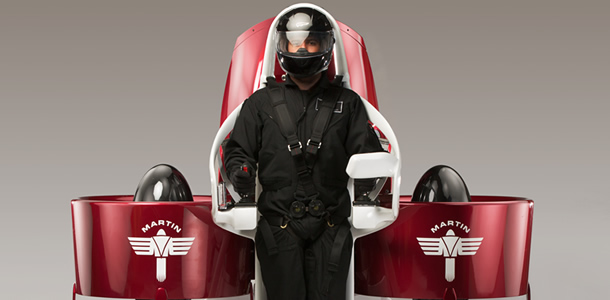
Despite the natural media attention on the recreational potential of single-person powered flight, Martin Aircraft has more serious market segments in mind for first sales of the Martin Jetpack.
Industries from retailing to media through to financial services have been shaken up by “disruptive” technology – now it is the turn of aviation and transportation. At least, that’s the intention of Christchurch-based Martin Aircraft Company, which is coming to the Australian Securities Exchange (ASX) with a $25 million initial public offering, issuing up to 50 million shares at 50 cents each. The issue represents 22.2% of the company’s capital: at 50 cents, with the maximum raise, Martin Aircraft will be capitalised at $112.6 million on the ASX.
The issue will fund the development of Martin Aircraft’s disruptive technology, its proprietary Martin Jetpack, which it calls the “world’s first practical jetpack.” The Martin Jetpack is a one-person aircraft powered by a V4,, two-stroke, 200-horsepower engine driving two ducted fans, which produce a straight jetstream of air. The Jetpack can be flown by a pilot or unmanned, through remote control.
It has undergone test flying and a prototype has been successfully flown, unmanned, to an altitude of about 1,500 metres above sea level. In manned flight, the Jetpack has already achieved forward speeds of up to 35 kilometres an hour, and computer modelling indicates that it could fly at speeds of up to 100 kilometres an hour. The first commercial product is expected to be limited to 1,000 metres in altitude and 74 kilometres an hour.
The Martin Jetpack was initially conceived of and developed by Glenn Martin in Christchurch in 1981, in response to another jetpack that had less than a one-minute flight-time limit. The present Jetpack is prototype 12, which is used mainly for testing, but is also used for promotions and demonstrations.
The use of ducted fans has a fundamental safety advantage over propellers and rotors: the tips of the blades are contained within the duct and are less of a safety hazard than exposed blades. The Jetpack flight control system is computer-controlled and stabilised. A key safety system is the parachute system, which enables the pilot to be saved in the case of a catastrophic failure down to a low height.
Managing director – and former RAF pilot – Peter Coker says the company aims to revolutionise the industries of aviation, recreation and transportation. Despite the natural media attention on the recreational potential of single-person powered flight, Coker says Martin Aircraft has more serious market segments in mind for first sales of the Martin Jetpack.
“We’re focusing initially on the global ‘first responder’ market, which includes fire service, police, ambulance and search and rescue, including natural disaster recovery, all the way through services such as surf patrol and border patrol. This aircraft can save human lives,” he says.
“Also, clearly the military will be interested in this, particularly around forward supply, access to difficult terrain, and ship-to-ship transfer, but there are also commercial aspects for the mining industry, farming, and the oil and gas industry. And later, there is a market opportunity for the recreational world, both from the perspective of the personal aircraft and entities like flying schools,” says Coker.
Initial production will be based on the current Prototype 12, which will also be used for the Jetpack Experience recreational opportunity. Coker says Martin Aircraft will continue to develop the Jetpack, as well as the unmanned model, the Martin Skyhook.
“We have the capability to build both manned and unmanned versions, and so it opens up both market spaces. But our real point of difference is the manned capability, because we’re finding – certainly in some of the potential first-responder customers – that the ‘man in the loop’ is still required, based around decision-making and tactical knowledge.”
However, the unmanned area is also a big opportunity, he says. “We can create an unmanned version of the Jetpack that can lift more than 100 kilograms. So in some respects we fit right in between the small end of unmanned aerial vehicles (UAVs), which are the small quad-copters that carry cameras, and the larger end, which are the large military and civil UAVs that do eight or nine hours of surveillance. Having something in the middle of that range, which can lift more than 100 kilograms, is extremely complementary across that market, and opens up a large market for us,” says Coker.

"It’s a three-pronged effort to move from the IPO
towards that first sale, which we anticipate will
be in the second quarter of (calendar) 2016,"
Martin Aircraft MD Peter Coker
Initially, the aircraft will be assembled at the company’s facility in Christchurch. Coker says a lot of the parts will be outsourced, with Martin Aviation owning the intellectual property (IP) and the prototyping, and doing the assembly.
“The test schedule is the priority, we want to finish development and move towards the pre-production and production. After that we will build a number of pre-production models, which we will use for demonstration purposes, towards the middle of 2015,” he says.
In conjunction with the testing schedule and final development design, the funds raised will also be applied to building the sales and marketing operation – a vice-president of sales and marketing will be starting before the end of the year – and the production team and the flight operations team, along with the management team. “Finally we are looking at the manufacturing, which looks at global supply chain of parts and components, production, assembly and finished product. So it’s a three-pronged effort to move from the IPO towards that first sale, which we anticipate will be in the second quarter of (calendar) 2016,” says Coker.
Martin Aircraft is using the ASX OnMarket BookBuild facility, which is designed to widen the reach and potential participation of a capital raising. Any investor can bid, through their broker, into the BookBuild facility. If an offer is over-subscribed brokers can receive full allocations or receive extra stock from the deal’s lead managers – but every bidder pays the same final price for the new shares.
Up to 10 million of the 50 million shares are being offered into the OnMarket BookBuild. The ASX code for the Martin Aviation BookBuild is MJPXBB. The offer is scheduled to close on Friday 28 November, although it may close early. The minimum allocation is 4,000 shares, or $2,000.
“From our perspective the OnMarket BookBuild looks like a highly complementary environment to engage with a number of brokers, and alleviate a number of the potential problems you can find with having one lead broker running an issue,” says Coker. “It’s a very clever way of actually allowing more investors to have access to a new issue.”
Because Martin Aircraft is pre-revenue, Coker is not expecting much in the way of institutional participation. “We are a non-revenue company and the risk profile against that is probably not acceptable to institutions, but that does not mean there is no interest. There are quite a few institutional investors around the world having the conversation with us now, such that they can potentially come in down the track. There is also an element of institutional investors that look at a risk profile like ours as being slightly different to where they’ve operated before, and that’s actually of interest to them, it’s a bit of a diversifier – we have had a number of those sorts of discussions with institutions,” he says.
On listing, founder (and non-executive director) Glenn Martin will hold just under 19% of the company, while Wellington-based specialist technology venture capital firm No 8 Ventures will be the largest holder, with just under 23%.
Further information on the Martin Jetpack is available on the Martin Aircraft website – www.martinjetpack.com. Applications for the IPO can be made via the ASX On Market Bookbuild Facility using the code is ASX: MJPXBB. To download a copy of the prospectus and application form visit – https://events.miraqle.com/Martin-Aircraft-Offer/Validation.







